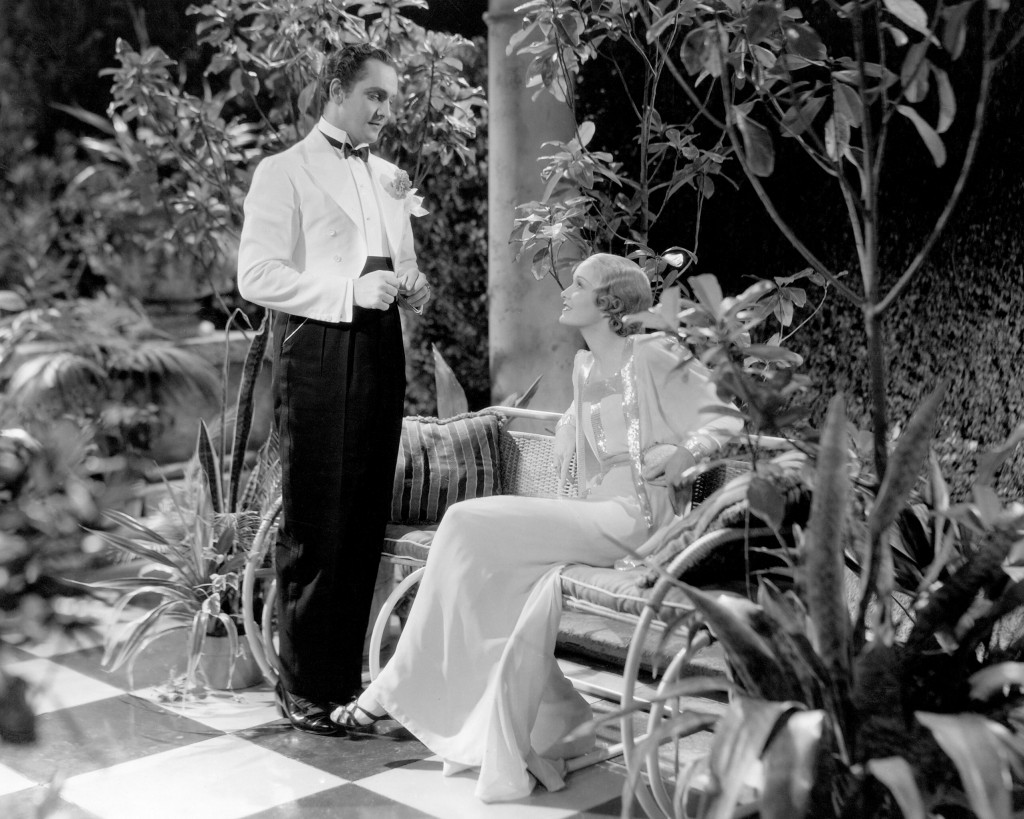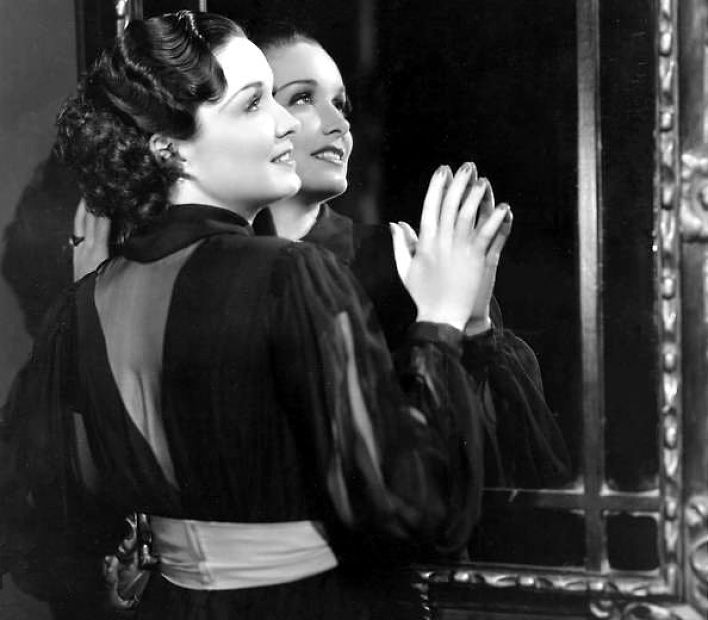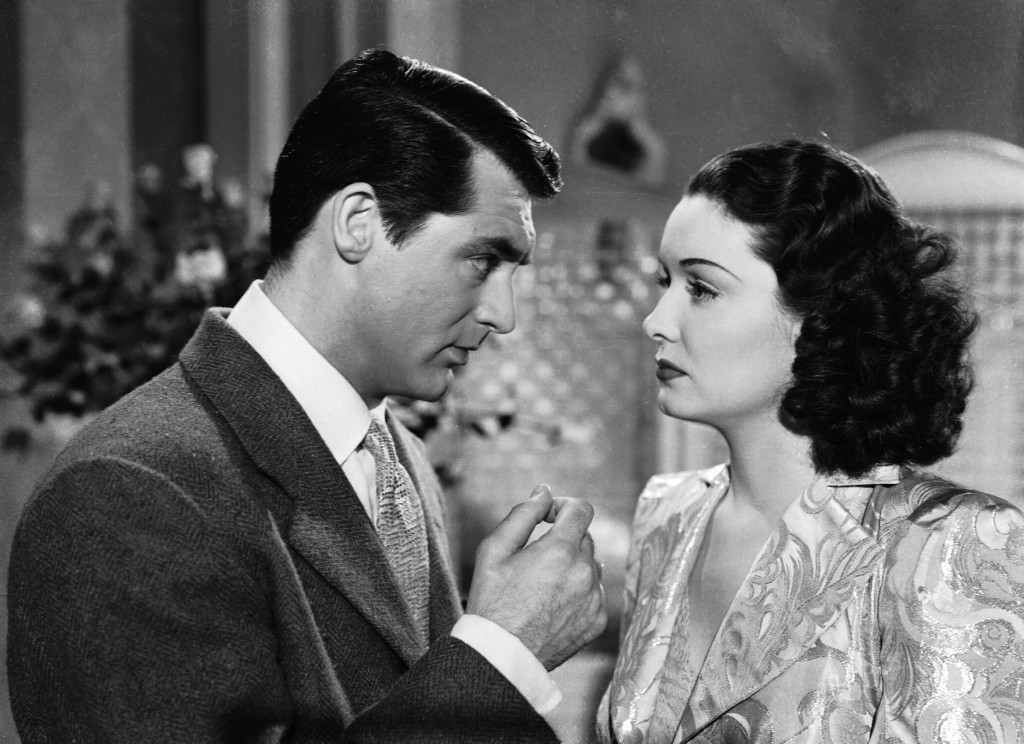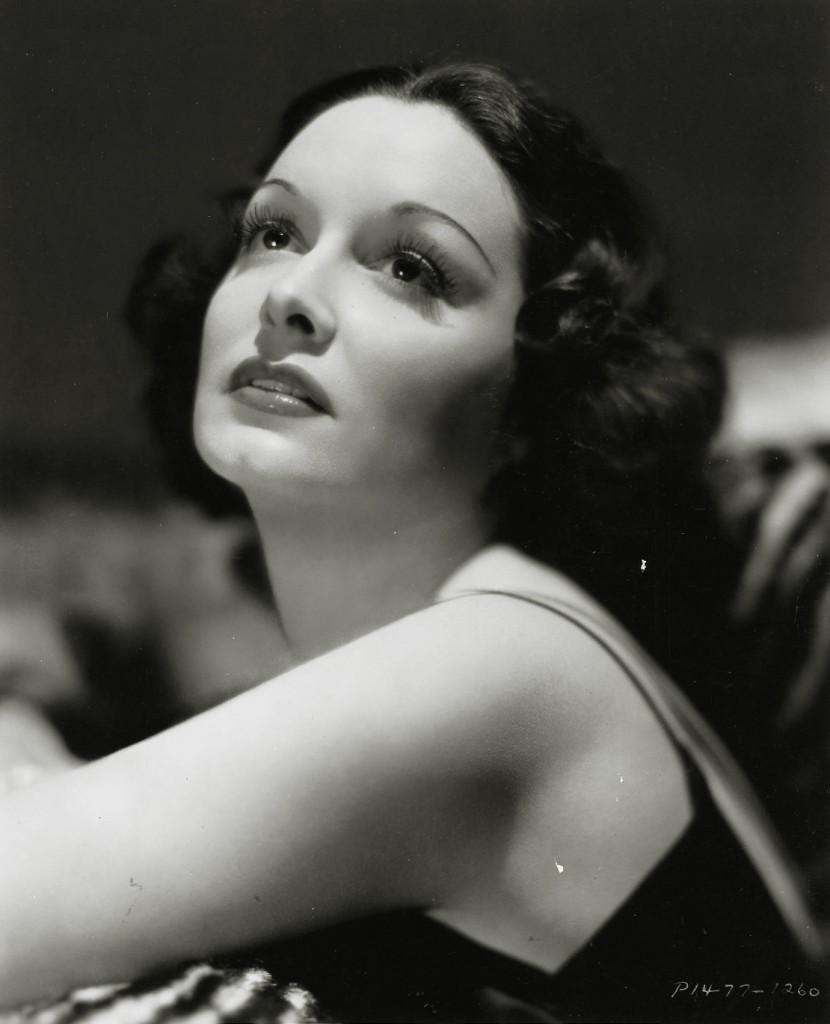Gail Patrick was the perfect contrast for such sweet and adorable blond stars as Carole Lombard in My Man Godfrey and Irene Dunne in My Favorite Wife. She could also play the perfect bitch, roles that didn’t seem to phase her. She knew that with her tall, lithe figure, she was also the perfect model, and she need never be intimidated in any room, especially with a Baccalaureate degree tucked away in her purse pocket.
This post is part of the Classic Movie Blog Association’s Forgotten Star Blogathon.
Gail Patrick was born Margaret LaVelle Fitzpatrick in Birmingham, Alabama, on June 20, 1911, She had an older and a younger brother, and thus grew up competing for attention. Her family was very social, and in the Southern manner, talk and storytelling were part of the environment. Gail received a B.A. from Howard College where she also served as dean of women for a period. She pursued a law degree at the University of Alabama, but after entering a publicized nation-wide contest by Paramount Pictures to play the “Panther Woman” in Island of the Lost Souls in 1932, she gave up her academic life and went Hollywood. She lost the role to Kathleen Burke, who she nonetheless befriended. It turned out to be a good thing for Gail, her friend Kathleen later related to her that she could never get another good role after being identified as “the Panther Woman.”

Gail was nevertheless placed on contract at Paramount Pictures for $50 a week. Not a large sum by movie star standards but a lot of money compared to what many people were earning during the Depression. She was given several uncredited roles in 1932-1933, and with her legal education she quickly negotiated her salary to $75 a week, and added a clause in her contract that she would not pose for cheesecake photos. In 1934 she played a minor role in a more important film, Death Takes a Holiday, shown above. It was directed by Mitchel Leisen and starred Frederick March and Evelyn Venable. In what would later be remade as Meet Joe Black. This was Gail’s first film to be dressed by the talented Travis Banton. From here on, with the exception of a few westerns, Gail Patrick would be a fashion plate on film.
In the photo above Gail Patrick does her best dark Marlene Dietrich imitation in a publicity shot for Mississippi, 1935. The movie has apparently never made it to video or DVD, but was a classic pairing of W,C Fields and Bing Crosby. Crosby played Gail’s beau, until he didn’t meet up to her Southern ideals, whereupon he was relegated to her sister Joan Bennett’s attentions. This was one of eight movies Gail Patrick made in 1935.
Gail’s tough sister act in Mississippi must have made an impression on director Gregory LaCava, who cast her as Cornelia Bullock, the tough and jealous socialite sister of Carole Lombard in the wonderful My Man Godfrey. As Cornelia she tries her best to get William Powell as Godfrey fired since she couldn’t win his attention. As devious as Cornelia is in the movie, and in the best use of characterization, one can be redeemed, and here we see Gail/Cornelia transformed by the nobleness of Godfrey.

Gail married Robert Howard Cobb in 1936, the first of her four husbands. He was the owner of the famed Brown Derby restaurant in Hollywood. The second was the derby-hat shaped restaurant on Wilshire Boulevard accross from the Ambassador Hotel, and its famed Coconut Grove lounge. All were famous as hang-outs for the stars. Alas , all are now gone. One lasting tradition, the Cobb salad, invented at the Brown Derby and named after its owner.
Gail played a leading role in a little known film titled Her Husband Lies (originally The Love Trap), from 1937. The story is based on the character of the notorious gambler and gangster Arnold Rothstein (characterized in Boardwalk Empire). Gail plays a nightclub singer married to Spade Martin played by Ricardo Cortez as the Rothstein character. He swore to his wife he was going straight but due to a variety of circumstances involving his younger brother, he gets sucked back into the underworld of gambling. Gail goes back to singing torch songs at the nightclub, and film noir starts early in this movie from the late 1930s.
Gail was dressed by Edith Head in this film as Travis Banton was having his problems with alcohol. Edith would soon be made head designer at Paramount. She followed his advice though, “When in doubt, trim in fur.”

Gail’s next big role was as a society beauty in Artists and Models, in 1937, co-starring Jack Benny, Ida Lupino, and Richard Arlen. The movie was a Paramount take-off from the Shubert’s Broadway Revues of the same title, the musical and chorus-girl themed shows popular in the 1920s. The central plot involved the production of the Artists and Models Ball. Jack Benny as the Ball Chairman had offered the “Queen of the Ball” role to his girlfriend Ida Lupino, a working class girl. But then he meets society girl Gail Patrick playing the part of Cynthia Wentworth, selling tickets for a charity benefit, and he offers her the “Queen of the Ball” role. The plot hinges somewhat on who will win out, but the real action is in the models and the musical numbers, including numbers by Louis Armstrong and Andre Kostelanetz. A real controversy ensued from the film’s showing in the South due to the musical number with Martha Raye, this due to her apparent interacting with the black musicians and dancing and gyrating in a style of the “negroes.”*
With all the emphasis on fashion and the musical stage costumes, Travis Banton got serious and produced some beautiful costumes for the film

Her next film was another classic and one of my favorite movies, Stage Door (below), directed by Gregory LaCava, whom she had worked with in My Man Godfrey, but this time at RKO. Before The Women, this was the women’s film par excellance. Its cast is a good indication of that: Katharine Hepburn; Ginger Rogers; Eve Arden; Lucille Ball; Ann Miller; Constance Collier; Andrea Leeds and of course Gail Patrick. Moreover, they are all roomates at the Footlighters Club, a boardinghouse for aspiring actresses in New York, supporting (or competing with) each other for roles on the stage. Constance Collier serves as a reminder of how it can all go bad, a sort of Norma Desmond without the mansion. This is also the model movie for delicious wisecracking and the women’s dialogue talking all over each other. The instant antagonism between roomates and polar opposites played by Katharine Hepburn and Ginger Rogers reflected their own rivalry at RKO, and the boarding house rivalry between the Ginger Rogers and Gail Patrick characters is feisty to say the least, spiced up with the wisecracks of Eve Arden and Lucille Ball, some of it apparently improvised. Only the Andrea Leeds character is innocent, a victim of the system. Competing for roles and sometimes competing for the same men, Stage Door shows the highs and lows of the stage life.
The women’s wardrobe for Stage Door was designed by Muriel King, a freelance costume designer and fashion designer.
Several B movies and smaller roles followed: Mad About Music; Dangerous to Know; Wives Under Suspicion; King of Alcatraz; Disbarred; Man of Conquest; Grand Jury Secrets; Reno; and The Doctor Takes a Wife, where she plays the “other woman” to Loretta Young.
And then came My Favorite Wife, 1940, where the “other woman” role got really close to importance, as the groom was Cary Grant. As character Nick Arden he was finally free to marry Gail playing Bianca Bates after his wife was declared dead after seven years of being missing at sea. The couple drive off to a honeymoon at a Yosemite lodge, unfortunately the same spot of his first honeymoon, where the now just-returned first wife played by Irene Dunne goes looking for him. Plenty of surprise, embarrassment, and consternation is had by all. And then Cary has to make a decision between her and Irene Dunne. Maybe Randolph Scott that Dunne dragged home with her from the shipwreck island where they lived together will complicate things sufficiently, it certainly did with the movie’s censor. Now if only his wife will take him back, but which one?
This was another RKO film, directed first by the talented Leo McCarey, but following a serious car accident Garson Kanin finished directing the film. Costume designer Howard Greer, formerly at Paramount, who now had his own fashion business based in Los Angeles, designed the women’s wardrobe.
By 1941 Gail had perfected the “other woman” role, as she was once again cast the part, this time as William Powell’s old flame in Love Crazy. In this film he’s married to Myrna Loy, and they are about to enjoy their 4th wedding anniversary when the mother-in-law visits, slips on a carpet, sprains an ankle and prolongs her visit. It’s his job now to go mail an important letter since his wfe was out, whereupon, low-and-behold, he runs into his old flame Gail in the elevator, finding out that she has just moved into the building with her husband. Sure enough, the elevator breaks down and he ends up with a concussion, but with some special nursing by Gail as seen above, a spark is relit (enough for the plot amyway). There are complications galore, although everyone ends up with their respective spouses, Gail Patrick is all fun in this movie, and as usual beautifully dressed.
No costume credit is given in the film, a time of transition between several designers coming and going at MGM. But my eye says it was designed by Adrian.
Gail starred in the Tales of Manhattan in 1942 and Hit Parade of 1943, as seen above. She appeared in several more films through the mid 1940s, but none with any major roles. She retired from acting in 1948, her last film being The Inside Story, produced at Republic Pictures, one of the “Poverty Row” studios.
In 1947 she married Thomas Cornwell Jackson, her third husband. He was the literary agent for Erle Stanley Gardner, who wrote the Parry Mason mysteries. Gail and her husband produced the TV show based on the book series, which ran from 1957 – 1966. For a few years previously she also designed a line of children’s garments.
Gail Patrick died in 1980 of leukemia at age 69. She bequeathed $1 million to her sorority Delta Zeta, the largest gift it has ever received.
*American Film Institute, Catalog of Feature Films. Artists and Models. http://www.afi.com/members/catalog/DetailView.aspx?s=&Movie=5196
Views: 1513









See we are not all rednecks.we put a man on the moon and we supply the space station.we are working to put people on Mars.we have the second highest number of Ba’s in the country.we just became the largest city in Alabama.
The best of Gail Patrick is her 1930’s beauty. for Her rounded front, for her elegant eyebronws and her beautiful blunt face (she hadn’t a sharp face) the result is her face is very similar to 1937’s Snowhite. Her voice is very elegant too, But even when she’s quite, she’s creepy. I like her cynical smile
Agree with and can’t say it better than the other comments here, enjoy seeing her in pretty much anything, such sass :). Great choice because she was essential in so many movies and was involved in iconic tv too. Great post.
Thanks Kristina, I’m glad you visited my post. It was gratifying to give a bit of the back story to Gail,
who otherwise could appear to be so cold on screen. Cheers.
Thank you for this fantastic post on Gail Patrick! I knew her mainly from her “perfect bitch” roles so I really enjoyed your comprehensive look at her career. I also had no idea that she was such an educated, accomplished woman! Beautiful images, and I appreciated your discussion of her costumes. Thanks!
I’m glad you liked the post on Gail Patrick, Cameron, I thought she needed a little sympathy.And who can resist those looks that the designers dressed her in. Thanks for your comment.
Ooh! I love Gail Patrick! She is the perfect character foil for the likes of Carole Lombard, Irene Dunne, et al – tall, cool, calculating. And someone who deserves to be more well known than she is.
Also, I liked the advice, “When in doubt, trim with fur.” I will keep this in mind. 🙂
Thanks SilverScreenings. She was definitely the spice in the mix, so its nice to talk a bit about who she was behind the scenes. I’m glad you enjoyed the post, and that you can still appreciate fur, faux or not.
Gail Patrick! As if giving us TVs Perry Mason wasn’t enough, she is marvelous to look at and a master with a sarcastic line.
Good news dept: “Mississippi” is available in the DVD set “The Bing Crosby Collection” along with “College Humor”, “We’re Not Dressing”,”Here is My Heart”, “Sing You Sinners” and “Welcome Stranger”. Gail couldn’t be meaner.
Terrific career retrospective, Christian. Patrick’s one of the most interesting actresses in classic cinema, to me – she could say more by just standing there than many others could with dialogue. And I love knowing she’d gotten an education before venturing into Hollywood.
surora
Thanks for your comment Aurora. She was smart and made the most of the roles she had. Long before picking her for the blogathon, I was always aware of her presence in the movies she appeared in. So “Forgotten Star” never really applied in her case as far as I’m comcerned.
Love your description of Constance Collier’s character in Stage Door – Norma Desmond without the mansion!
She’s wonderful in Stage Door. Just so good at making you hate her, just like in My Man Godfrey. I’ll have to check out Love Crazy. Thanks for the rec!
Thanks Leah, I’m glad you enjoyed the post. I think you’ll enjoy Love Crazy, even though you won’t her as much!
A lovely post on one of my favorites. Such a good choice for this blogathon.
Thanks for the comment Jacqueline. I’m glad you enjoyed it and that you appreciate Gail Patrick, you have to dig below the surface to find the real person.
Very interesting background on Gail Patrick – who I’m mostly familiar with through “My Man Godfrey” and “My Favorite Wife.” I’ve always thought Godfrey should have ended up with the rehabilitated Cornelia rather than way-too-screwball Irene, by the way.
Always wondered about Gail Patrick’s path to becoming a producer on the Perry Mason TV series, now I know.
Thanks for the comment Lady Eve. Her background wasn’t typical, other than being able to look good in those glamour gowns of the 30s. I have to say I liked her sass, but I liked her best in Love Crazy, unabashed in making her moves on William Powell and having fun in the process, mostly at seeing his embarrassment I think. And anyway, two of my other blogathon picks were already chosen so I went for the unpopular clotheshorse.
This was one interesting woman and actress. I always had an initial dislike of her, probably due to the kind of parts she played (a sign of a good actress), but once I started paying more attention to her and learning about her, I became a fan. I did a post about her a long time ago and just recently someone left a comment about how great she would have been as Scarlett O’Hara. Interesting, right? Great post, Christian, and your choice of photos are, as always, perfection.
Thanks for your comment FlickChick. It’s nice that you had done a post on Gail Patrick. She does not come across
as very likable, a result of her roles unfortunately. And I’m sure she was tough enough in real life when she had to be. She already had a career path before she came to Hollywood, so she knew she could walk away whenever she wanted to. I don’t remember if she was a contender for Scarlett, everyone was it seems, but as a Southerner and a good actress she could have pulled it off.
Silver Screen Modes- Gail Patrick: The Forgotten Star http://t.co/LhN8JwAm3T